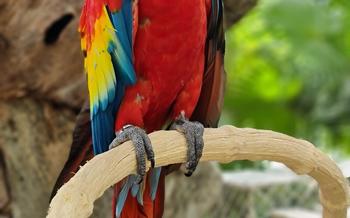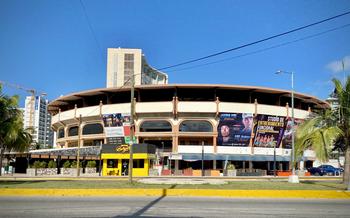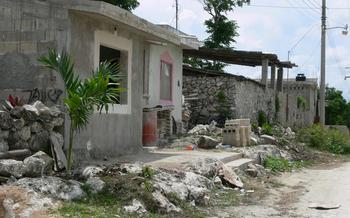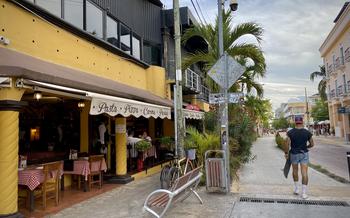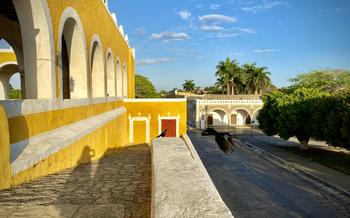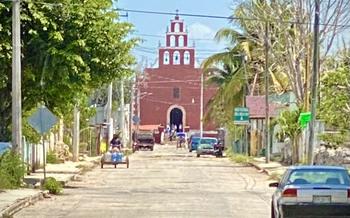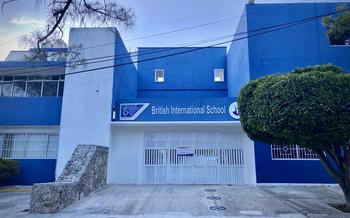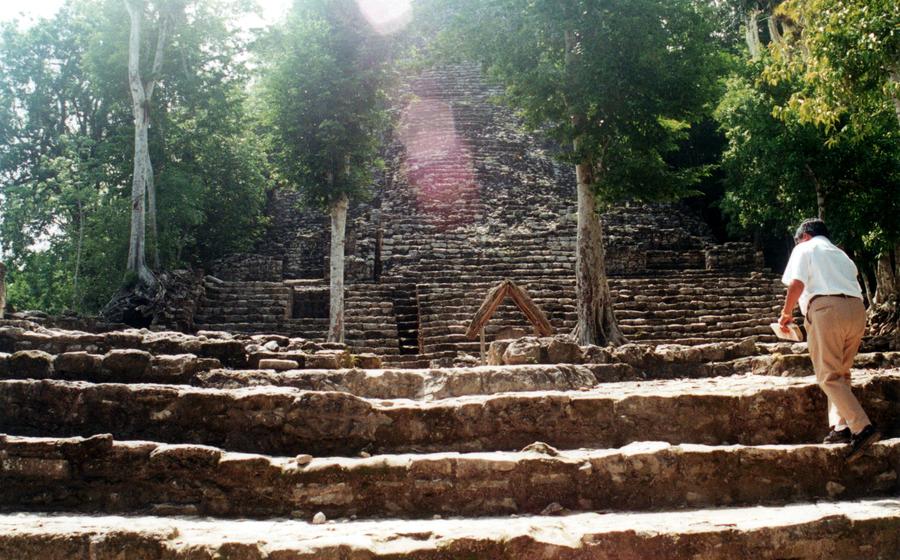
Coba
- Historical Significance
- Ball Courts
- Sacbeob Roads
- Stelae and Altars
- Temple of the Painted Lintels
- Group B: Exploring a Residential and Ceremonial Complex
- Group C
- Wildlife and Nature
- Local Cuisine and Culture
- Shopping for Souvenirs
- Day Trip or Overnight Stay:
- Photography Tips
- Insider Tip: Discover the Hidden Cenote Multun-Ha
Historical Significance
Coba, an ancient Mayan city nestled in the heart of the Yucatan Peninsula, beckons travelers to delve into the depths of its rich history and cultural legacy. As one of the largest Mayan cities, Coba flourished as a ceremonial and trading center, leaving behind a treasure trove of ruins that captivate visitors to this day. The city's unique features set it apart from its contemporaries. Unlike other Mayan cities built on elevated terrain, Coba lies amidst a network of interconnected lakes and cenotes, creating a picturesque landscape that adds to its allure. Step into the annals of time as you explore Coba's ancient plazas, temples, and pyramids, each whispering tales of a civilization that once thrived in harmony with nature. Discover the secrets of the ancient Mayans as you wander through this living museum, connecting with the past in a place where history comes alive.
Ball Courts
The ancient Mayan game of pok-ta-pok, a ritualized ball game, was played in the impressive ball courts of Coba. These courts are among the largest and most well-preserved in the Mayan world, showcasing the city's significance as a sporting and ceremonial center.
The rules of pok-ta-pok were complex and involved using a solid rubber ball and hitting it with your hips, elbows, or knees to score points by passing it through stone hoops mounted on the walls of the court. The game held deep cultural and religious significance, with matches often played as part of festivals or to settle disputes.
Coba's ball courts are unique in their design and dimensions. The main court, known as Juego de Pelota, is the largest in the Yucatan Peninsula, measuring an impressive 166 meters long and 75 meters wide. The sloping walls of the court are adorned with intricate carvings and sculptures depicting Mayan rulers and deities, adding to the court's grandeur.
In addition to the main court, Coba has several smaller ball courts scattered throughout the city, each serving different purposes. Some courts were used for practice or training, while others were reserved for ceremonial games or competitions between different Mayan city-states.
Exploring the ball courts of Coba offers a glimpse into the sporting and ceremonial traditions of the ancient Mayans. The size, design, and intricate carvings of these courts speak to the importance of pok-ta-pok in Mayan society and the significance of Coba as a major sporting and ceremonial center.
Sacbeob Roads
The ancient Mayans were skilled engineers and builders, and their road system, known as sacbeob, is a testament to their ingenuity. These elevated causeways, constructed using limestone and rubble, connected Coba to other important cities and trading centers in the region. The sacbeob were meticulously built, often running in straight lines for kilometers, and were wide enough to accommodate two people walking side by side.
The sacbeob served several important purposes. They facilitated trade and communication between different Mayan cities, enabling the exchange of goods, ideas, and technologies. They also played a role in religious processions and pilgrimages, as they often led to sacred sites and temples. Additionally, the sacbeob served as a defense mechanism, as they allowed the Mayans to quickly transport troops and supplies in times of conflict.
At Coba, there are several well-preserved sacbeob that visitors can explore. One of the most impressive is the sacbe that leads from the main city center to Group C, a residential and ceremonial complex located about 1 kilometer away. This sacbe is over 10 meters wide and is flanked by low walls on either side. Walking or biking along this ancient road is a unique and immersive experience, offering a glimpse into the engineering prowess and the interconnectedness of the Mayan civilization.
Anecdote:
As I walked along the sacbe leading to Group C, I couldn't help but feel a sense of awe and wonder. The sheer size and scale of this ancient road, coupled with its remarkable preservation, transported me back in time. I imagined the bustling activity that must have taken place along this route centuries ago, as traders, pilgrims, and warriors traveled between Coba and its neighboring cities. The sacbeob are a testament to the ingenuity and resilience of the Mayan civilization, and exploring them is a must-do experience for anyone visiting Coba.
Stelae and Altars
As you explore Coba, you'll encounter numerous stelae and altars, silent witnesses to the rich cultural and religious life of the ancient Mayans. These stone monuments, often intricately carved and adorned with hieroglyphs, provide valuable insights into their history, beliefs, and daily practices.
The stelae, tall and imposing, stand like guardians of time, narrating the stories of rulers, their conquests, and significant events. Their surfaces are etched with intricate glyphs, a complex writing system that recorded dates, genealogies, and historical accounts. Deciphering these glyphs is like solving a puzzle, unlocking the secrets of the past.
Altars, on the other hand, served as sacred platforms for offerings and rituals. Imagine the ancient Mayans gathering around these altars, their voices rising in prayers and chants, as they sought blessings, guidance, and protection from their deities. The altars are often adorned with elaborate carvings depicting gods, mythical creatures, and scenes from Mayan mythology, offering a glimpse into their spiritual world.
One particularly captivating stela is Stela 1, located near the main plaza. It stands over 13 feet tall and features a detailed depiction of a Mayan ruler, his elaborate headdress and ornate jewelry symbolizing his power and prestige. The accompanying hieroglyphs recount his lineage and accomplishments, providing a glimpse into the life of an ancient Mayan leader.
Exploring the stelae and altars of Coba is like embarking on a journey through time, uncovering the layers of a rich and vibrant civilization. Each monument tells a story, offering a deeper understanding of the people who once called this place home.
Temple of the Painted Lintels
Among the many impressive structures in Coba, the Temple of the Painted Lintels stands out with its vibrant colors and intricate carvings. Located in the heart of the city, this well-preserved temple offers a glimpse into the artistic and religious traditions of the ancient Mayans.
The temple's most striking feature is its series of painted lintels, which depict various scenes from Mayan mythology and history. These lintels, made of wood and covered in a layer of stucco, showcase a remarkable level of craftsmanship and artistic skill. The paintings depict figures engaged in rituals, battles, and other activities, providing valuable insights into the beliefs and daily life of the ancient Mayans.
In addition to the painted lintels, the temple's exterior is adorned with elaborate carvings. These carvings depict a variety of motifs, including serpents, birds, and human figures. The intricate details and symbolism of these carvings further enhance the temple's significance and beauty.
Inside the temple, visitors can admire the remains of murals that once covered the walls. These murals, though faded over time, still offer a glimpse into the vibrant colors and imagery that once graced the temple's interior.
Exploring the Temple of the Painted Lintels is a truly immersive experience that transports visitors back in time. The temple's well-preserved state and intricate artwork make it a must-see for anyone interested in Mayan history and culture.
Anecdote:
As I stood before the Temple of the Painted Lintels, I couldn't help but feel a sense of awe and wonder. The vibrant colors and intricate carvings seemed to come alive before my eyes, transporting me back to a time when the ancient Mayans worshipped their gods and conducted their rituals within these sacred walls.
I spent hours exploring the temple, marveling at the details of each lintel and carving. The scenes depicted on the lintels were so vivid and expressive, telling stories of battles, ceremonies, and everyday life. It was as if the ancient Mayans were inviting me to step into their world and witness their rich culture firsthand.
The Temple of the Painted Lintels remains one of my most cherished memories from my travels in Coba. It is a testament to the artistic genius and spiritual beliefs of the ancient Mayans, and I highly recommend it to anyone seeking a deeper understanding of this fascinating civilization.
Group B: Exploring a Residential and Ceremonial Complex
As you venture deeper into Coba, you will discover Group B, a complex of residential and ceremonial structures located near the main city center. This group offers a glimpse into the daily lives and rituals of the ancient Mayans.
Group B consists of a variety of buildings, including temples, palaces, and residential platforms. The temples are adorned with intricate carvings and sculptures, showcasing the artistic and religious traditions of the Mayans. The palaces, once the homes of the city's elite, provide insights into the luxurious lifestyle of the ruling class. The residential platforms, where ordinary people lived, offer a glimpse into the domestic life of the ancient Maya.
The significance of Group B lies in its function and relationship to the rest of the city. It served as a residential area for the ruling elite and their families, as well as a ceremonial center where religious rituals and ceremonies took place. The proximity of Group B to the main city center suggests its importance in the political and religious life of Coba.
Anecdote:
During my exploration of Group B, I stumbled upon a particularly well-preserved temple. The intricate carvings on its facade depicted scenes from Mayan mythology, offering a glimpse into the beliefs and spiritual practices of the ancient Maya. The temple's interior was adorned with colorful murals, which had remarkably survived the passage of time. I spent a long time marveling at the artistry and craftsmanship of this sacred space, feeling a deep connection to the history and culture of the Mayans.
Group C
Group C is another residential and ceremonial complex located further away from the city center of Coba. It is smaller in size compared to Group B, but still holds significant historical and cultural importance.
Group C consists of various types of buildings, including temples, palaces, and residential platforms. The temples in this group are smaller in size compared to those in Group B, but they still feature intricate carvings and decorations. The palaces are believed to have been the residences of the ruling elite, and they often have multiple rooms and courtyards. The residential platforms, on the other hand, were where the common people lived.
Group C is believed to have been a residential area for the elite and their families, as well as a place for religious ceremonies and rituals. It was likely connected to the main city center by a network of sacbeob, or ancient Mayan roads.
Exploring Group C offers visitors a glimpse into the lives of the ancient Mayans and their social structure. It is a quieter and less crowded area compared to the main city center, allowing visitors to appreciate the ruins in a more peaceful and intimate setting.
Wildlife and Nature
Coba is nestled within a diverse ecosystem that harbors a rich variety of flora and fauna. As you explore the ancient ruins, keep an eye out for the playful spider monkeys swinging through the trees, the colorful toucans flitting among the foliage, and the majestic eagles soaring overhead. The area is also home to a variety of reptiles, including iguanas, snakes, and turtles, which can often be spotted basking in the sun or hiding among the rocks.
Beyond the ruins, the surrounding jungle offers opportunities for nature enthusiasts to immerse themselves in the wonders of the Yucatan Peninsula's biodiversity. Take a refreshing dip in one of the many cenotes, where you can snorkel or dive amidst a kaleidoscope of tropical fish and admire the intricate underwater formations. Hike along the nature trails that wind through the jungle, discovering hidden waterfalls, lush vegetation, and exotic bird species.
Remember that preserving the natural environment is essential for the well-being of both wildlife and the local communities. Please practice responsible tourism by staying on designated trails, respecting wildlife, and avoiding littering or disturbing the fragile ecosystem. Your actions can help ensure that future generations can continue to enjoy the beauty and biodiversity of Coba and its surroundings.
Anecdote:
During my visit to Coba, I had an unforgettable encounter with a family of spider monkeys. As I sat quietly observing them from a distance, they swung closer, their curious eyes fixed on me. The playful antics of the baby monkeys, clinging to their mother's back and swinging from branch to branch, filled me with joy and wonder. It was a magical moment that reminded me of the interconnectedness of all living beings and the importance of protecting their natural habitats.
Local Cuisine and Culture
Immerse yourself in the vibrant flavors of the Yucatan Peninsula's cuisine during your visit to Coba. Traditional dishes, such as cochinita pibil (slow-roasted pork in achiote sauce), panuchos (fried tortillas topped with beans, meat, and vegetables), and papadzules (rolled tortillas filled with eggs and pumpkin seed sauce), tantalize taste buds with their unique blend of Mayan and Spanish influences.
Indulge in the region's street food scene, where you can savor freshly made tacos, tamales, and empanadas from local vendors. Don't miss the opportunity to try marquesitas, a local dessert consisting of a thin crepe filled with sweet fillings like Nutella, fruit, or cheese.
For an authentic culinary experience, visit local markets and restaurants in Coba. The Mercado Municipal is a great place to find fresh produce, spices, and traditional dishes. For a memorable dining experience, try the Restaurante Mayahuel, known for its delicious regional cuisine and live music performances.
Anecdote:
During my visit to Coba, I had the pleasure of dining at a local restaurant called "El Fogón Maya." The ambiance was warm and inviting, with colorful tablecloths and traditional Mayan music playing in the background. I savored every bite of my cochinita pibil, which was perfectly cooked and bursting with flavor. The staff was friendly and attentive, making my dining experience truly unforgettable.
Shopping for Souvenirs
Coba offers a delightful shopping experience for those seeking unique souvenirs and handmade crafts. The local markets and shops are a treasure trove of Mayan textiles, pottery, jewelry, and other traditional items. When shopping for souvenirs in Coba, it's essential to support local artisans who create these beautiful pieces. Bargaining is acceptable, but remember to do so respectfully and with a smile.
One of the best places to find souvenirs in Coba is the Coba Market, located near the main entrance to the archaeological site. Here, you'll find a wide variety of stalls selling everything from colorful hammocks and embroidered blouses to hand-painted pottery and intricate jewelry. Don't miss the opportunity to purchase a unique piece of Mayan art that will serve as a cherished reminder of your visit.
If you're looking for something truly special, consider visiting the workshops of local artisans in Coba. You can observe them creating their crafts and purchase directly from them, ensuring that your money goes directly to the source. This is a great way to support the local economy and take home a truly authentic souvenir.
Anecdote:
During my visit to Coba, I stumbled upon a small shop tucked away in a narrow alley. The shop was filled with beautiful hand-woven textiles, each one a unique work of art. I couldn't resist purchasing a colorful hammock as a souvenir, and I still cherish it as a reminder of my time in Coba.
Day Trip or Overnight Stay:
Whether to visit Coba as a day trip or opt for an overnight stay depends on your time constraints, budget, and desired experience.
Day Trip:
A day trip to Coba is feasible from nearby cities like Cancun or Tulum, allowing you to explore the main ruins, climb Nohoch Mul, and swim in a cenote. This option is ideal for those on a tight schedule or limited budget. However, keep in mind that a day trip may feel rushed, and you might miss the opportunity to experience Coba's unique atmosphere after the crowds have dispersed.
Overnight Stay:
If you have more time and want a more immersive experience, consider staying overnight in Coba. This will give you the chance to explore the ruins at a more leisurely pace, enjoy the tranquility of the site in the early morning or evening, and perhaps visit nearby attractions like the Punta Laguna Nature Reserve. There are several accommodation options in Coba, ranging from budget-friendly hostels to comfortable hotels, catering to different budgets and preferences.
Anecdote:
During my visit to Coba, I opted for an overnight stay, which allowed me to fully appreciate the site's magic. After a day of exploring the ruins and swimming in a cenote, I returned to my hotel in the evening, where I enjoyed a delicious Yucatecan dinner and relaxed in the peaceful ambiance of the town. The following morning, I was able to return to the ruins early, before the crowds arrived, and capture some stunning photos of the site bathed in the golden light of dawn.
Photography Tips
When visiting Coba, capturing the essence of this ancient city through photography is a must. Here are some tips to help you take stunning shots:
Use the Right Equipment: Invest in a good camera with a wide-angle lens to capture the vastness of the ruins. A tripod will also ensure stability for sharp images.
Consider Lighting Conditions: The best time to photograph Coba is during the early morning or late afternoon when the light is softer and more flattering. Avoid harsh midday sun, which can create harsh shadows and overexposed images.
Compose Your Shots Effectively: Experiment with different angles and perspectives to create dynamic compositions. Incorporate leading lines, such as the ancient roads or the towering pyramids, to draw the viewer's eye into the image.
Capture the Details: Don't just focus on the grand structures; look for the intricate details that make Coba unique. Close-ups of carvings, stelae, and other decorative elements can reveal hidden stories.
Photograph the Wildlife: Coba is home to a variety of wildlife, including monkeys, birds, and reptiles. Be patient and observant to capture these creatures in their natural habitat.
Anecdote: During my visit, I captured a breathtaking shot of the Nohoch Mul pyramid against a vibrant sunset sky. The warm hues of the setting sun illuminated the ancient structure, creating a magical and awe-inspiring image.
Insider Tip: Discover the Hidden Cenote Multun-Ha
For an unforgettable experience, venture off the beaten path and discover the hidden cenote Multun-Ha, located just a short bike ride from Coba's main ruins. Immerse yourself in the tranquil atmosphere of this secluded cenote, surrounded by lush vegetation and towering limestone cliffs. Take a refreshing dip in the crystal-clear waters, snorkel among the colorful fish, and bask in the natural beauty of this hidden gem.
This insider tip offers a unique opportunity to escape the crowds and experience the magic of Coba's natural wonders in a serene setting. Whether you're seeking tranquility, adventure, or a chance to connect with nature, Multun-Ha is a must-visit for anyone exploring the wonders of Coba.
